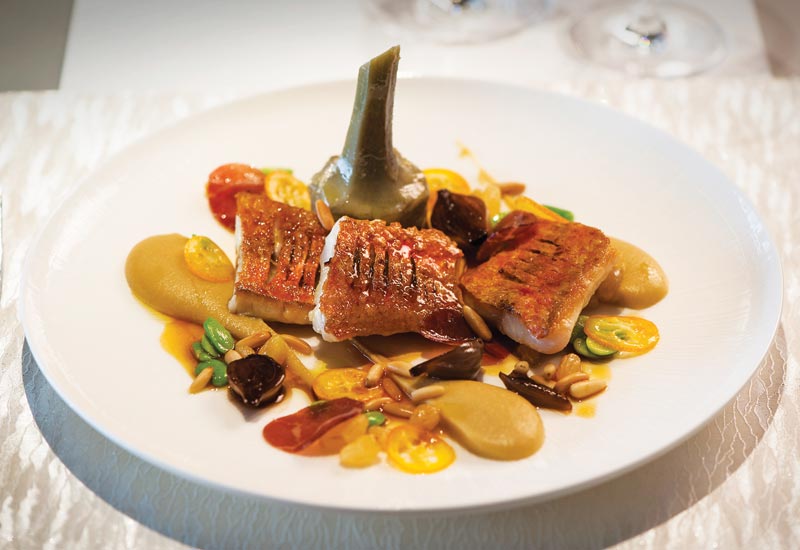Sustainable Fishing
It has long been established that overfishing in the Gulf is depleting stocks of key species popular on the region’s menus, including hammour, kingfish, gish and pomfret.
In March, mounting concerns prompted Dubai Municipality to announce a clampdown on sales of premature fish after its investigation revealed that many small fish continue to be sold in local restaurants.
To allow endangered species to reach breeding age, minimum lengths are already in place: between 17 and 45cm depending on species. Under the new campaign, inspectors will be issuing initial fines of AED 1,000 (US $272) on non-compliant fishermen and traders.

| Advertisement |
Although progress has been slow in some areas of the market, the Middle East’s seafood market is now taking sustainability more seriously than it did a year ago and a group of F&B operators are taking the lead in meeting their ecological responsibilities. For example, many chefs are phasing out endangered species from their menus, despite their popularity amongst locals.
“Sustainability is very important and everyone should discuss it and act now,” explains Miramar Al Aqah Beach Resort executive chef, K.A.C. Prasad. “If we continue the way we are going, our children will be buying fish at similar prices to a Ferrari!
“Over fishing, no controlling nor monitoring by authorities will badly affect the current supply around the world.
So last month at the World Association of Chef’s Society, we signed up to fight for this issue alongside 97 other countries.
“Our first step has been to remove hammour from the buffets and replace it with Nile perch. In the near future we expect to remove hammour from every menu to do our bit to stop over-fishing in the Gulf sea.”
Similarly, Shangri-La Hotels launched a sustainable seafood policy at the start of the year, phasing out shark fin and Chilean sea bass from all of its operated restaurants by the end of the year.
With growing consumer awareness, a robust sustainability policy – and evidence to prove that it is being delivered – is essential.
For example, Royal Culimer works hard to transparently communicate its sustainability credentials to clients, as managing director, Jeroen Tollenaar confirms: “We can firmly state our tuna is not endangered and the way we catch them is recommended by the WWF. We have noticed a strong increase in the number of consumers concerned about turtles and dolphins, which is encouraging. We only have to refer them to www.culimer.com to demonstrate that our tuna is sustainable: we have both scientific evidence and a tracking and tracing system in place to prove that this is the case.”
For many suppliers, action on sustainability in the region creates new business opportunities. The need for sustainable seafood offers the chance to differentiate product ranges and enter a growing market for alternative seafood from more sustainable sources.
As a result, many international suppliers are eyeing up the Middle East market, as it turns from a relatively closed market dominated by local fish species to an open, diversifying market on the lookout for sustainable alternatives.
It is this turn of events that has attracted the attention of the Sea Harvest Corporation. Specialising in Cape Hake, a fish popular in the West, the company has identified a potentially profitable niche by entering the market with a versatile white fish that is sustainable and consistent in quality and supply.
“The South African Hake fishery is a very well managed fishery and has been certified by the Marine Stewardship Council as a sustainable fishery since 2004,” explains Sea Harvest Corporation commercial manager, Konrad Geldenhuys. “Sustainable fishing practices have resulted in a very healthy resource and the Cape Hake quotas have been increased during the past three years.
“At Sea Harvest, we are growing our existing markets but we are also investigating new markets. We decided to exhibit at the Gulfood exhibition as part of the South African National Pavilion in 2011 to test the waters in this market and decided to exhibit again in 2012 to build on the positive feedback we received in 2011.”
This year Seafex, the Middle East’s biggest showcase and international trade fair for the seafood industry, is teaming up with Gulfood and will take place November 19-21 at Dubai World Trade Centre.
Balancing sustainability and growth is likely to be the key issue for the region’s seafood market in, at least, the medium term. As consumer tastes diversify, F&B operators can explore new species and develop their menus around more sustainable options.









 Search our database of more than 2,700 industry companies
Search our database of more than 2,700 industry companies









